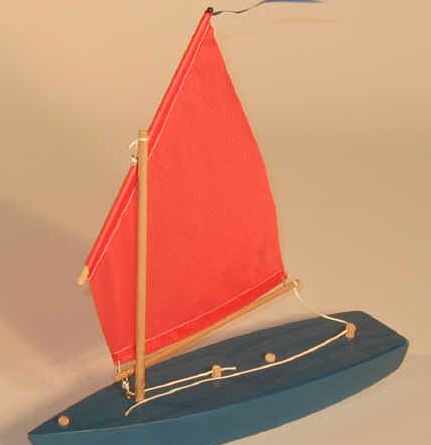Build a model sailboat
Build a model sailboat from cardboard or balsa, add a mast, sail, and keel, then test and adjust it in water to learn buoyancy.



Step-by-step guide to build a model sailboat
how to make a wooden model sail boat DIY wooden model boat
Step 1
Draw a boat hull shape on your cardboard or balsa about 20 cm long and mark the centerline with a pencil.
Step 2
Cut out the hull shape carefully along your pencil line using scissors or a craft knife.
Step 3
Bend or curve the hull gently so it has a rounded bottom to help it float.
Step 4
Secure the folded or curved shape with glue or strong tape so the hull keeps its rounded bottom.
Step 5
Cut a narrow slot in the bottom center of the hull along the centerline for the keel.
Step 6
Make a keel by shaping modelling clay into a narrow fin and press a small metal washer into it for ballast so the keel is weighted.
Step 7
Insert the weighted keel into the slot and glue or tape it firmly so it stays in place under the hull.
Step 8
Cut a wooden skewer or straw to about 18 cm long to make your mast.
Step 9
Cut a rectangle from scrap paper or light fabric about 10 by 12 cm to make a sail.
Step 10
Attach the sail to the mast with a small piece of tape or glue so the sail is secure and flat.
Step 11
Push the mast into the hull at the centerline and secure it with glue or tape so it stands upright.
Step 12
Seal the hull edges and any seams with clear tape or a coat of waterproof paint to help the boat stay dry.
Step 13
Place the boat gently in a tub or basin of water and watch how it floats and whether it tips to one side.
Step 14
Add or move small bits of clay to the keel or inside the hull to adjust the balance until the boat floats level and steady.
Step 15
Take a photo or write about your finished sailboat and share your creation on DIY.org
Final steps
You're almost there! Complete all the steps, bring your creation to life, post it, and conquer the challenge!


Help!?
What can we use instead of balsa wood, modelling clay, or a metal washer if we can't find them?
If balsa or thin cardboard for the hull (step 1) is unavailable, use corrugated cardboard or a recycled plastic container cut to shape, replace the modelling clay and metal washer ballast (step 6) with a wrapped coin or small nut, and substitute the wooden skewer mast (step 8) with a sturdy drinking straw or thin dowel while sealing seams with clear tape (step 11).
My boat tips to one side or leaks—what should I check and fix?
If the boat tips or leaks in the tub test (step 12), ensure the weighted keel is glued firmly into the slot (step 7), add or move small bits of clay to the keel or inside the hull to rebalance (step 13), and seal hull edges and seams with clear tape or waterproof paint (step 11) to prevent sinking.
How can I adapt this activity for different age groups?
For preschoolers have an adult pre-cut the hull and slot and let them tape on the mast and sail (steps 1–10), for 7–10-year-olds let them cut and shape the clay keel with supervision (steps 2–6), and for older kids encourage using balsa with a craft knife, sanding the curve, testing sail sizes, and experimenting with waterproof paint and balance adjustments (steps 2, 5, 8–13).
How can we extend or personalize the sailboat after it's finished?
Personalize and improve the boat by painting or decorating the hull and sail before sealing (steps 10–11), adding a cardboard rudder glued at the stern, trying different sail shapes and mast positions to see how they affect balance (steps 9–13), or making the mast removable so you can swap sails during testing (steps 9–13).
Watch videos on how to build a model sailboat
School Science Projects | Sail Boat Model
Facts about model boat building and buoyancy
⚖️ A keel or low ballast lowers a boat's center of gravity and greatly reduces the chance of capsizing, even on small models.
⛵ Small changes in a sail's angle (just a few degrees) can noticeably change speed and steering by altering how wind pushes the sail.
🧪 Archimedes' principle: a floating object is pushed up by a force equal to the weight of the water it displaces.
🌳 Balsa wood is incredibly light and buoyant—its density can be as low as about 40 kg/m³, which is why hobbyists love it for models.
🛁 Model builders often test boats in a bathtub or sink so they can quickly tweak hull shape, weight placement, and sail trim.
How do you build a simple model sailboat to learn buoyancy?
What materials do I need to build a model sailboat?
What ages is building a model sailboat suitable for?
What are the benefits and safety tips for building a model sailboat?


One subscription, many ways to play and learn.
Only $6.99 after trial. No credit card required



